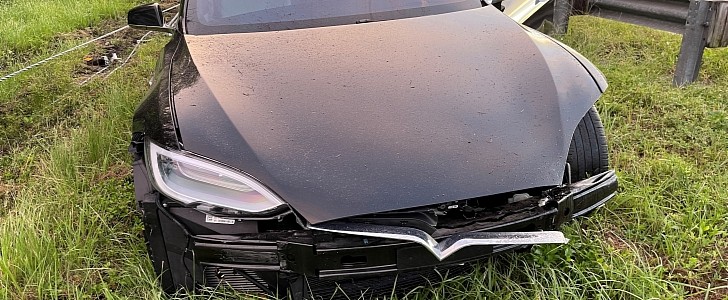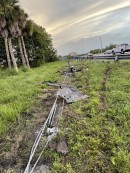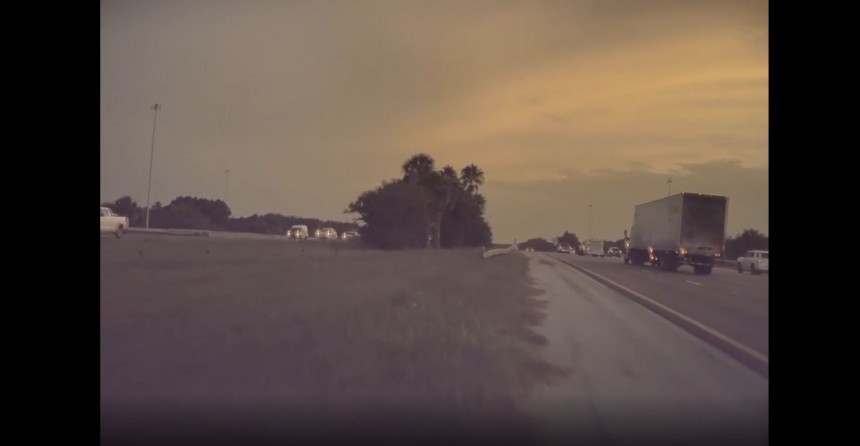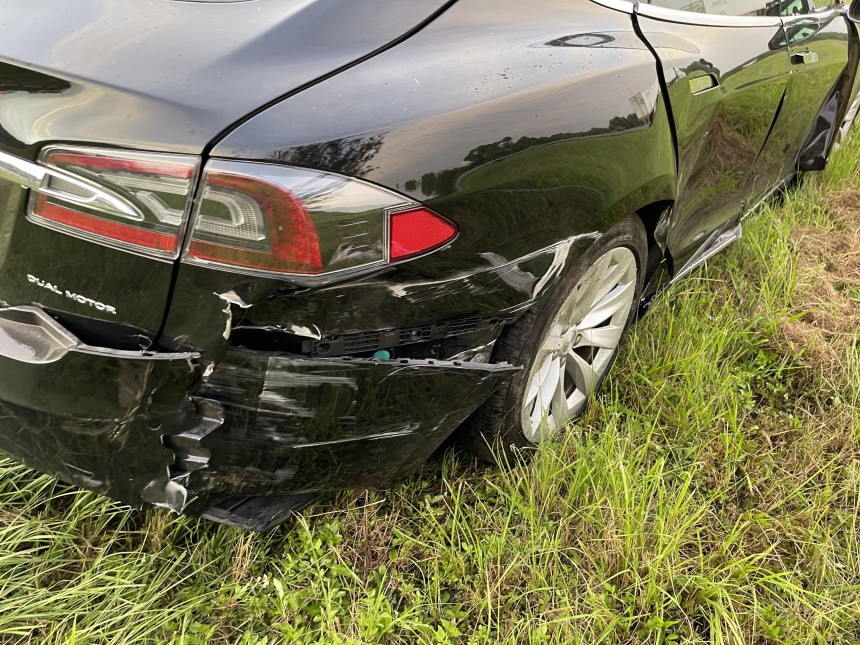A 2020 Tesla Model S was totaled after the EV unpredictably left the highway and went straight for the guard rails. Fortunately, nobody was hurt. The car, however, can’t be used anymore. For the owner, this is a dismal outcome. They had free Supercharging for life, and it isn’t transferable. Here’s what happened.
A Tesla Model S owner published a video of their car swerving left out of nowhere. It went right into the guard rails, which arguably saved the driver from slamming right into a tree.
The footage shows the Model S traveling in the left lane while a semi-truck is moving to the center lane with no clear intention of getting in front of the EV. However, the car abruptly goes left, leaves the highway, and ends in the guardrails, narrowly avoiding the barrier.
The car’s owner says on Reddit that they’ve had the “automatic driving” on and hints that it might be the Full Self-Driving’s (FSD) fault for the crash. The incident allegedly happened after about five miles of highway driving.
However, FSD – an advanced driver-assistance system (ADAS) that’s not yet finished and is being given to customers in Beta stage with the clear warning that they must always be responsible and attentive – doesn’t run on highways. It’s Autopilot (AP) or Enhanced Autopilot (EAP) that keeps the traveling vehicle in the lane and helps the driver avoid having to keep the accelerator pedal pressed or make sure they’re keeping a safe distance from the vehicle in front. If paid for, it can also work in stop&go traffic.
But the Tesla owner says the brakes didn’t work even though they tried to take control and stop. “My hands were on the wheel, I started to correct it after 1 second,” wrote the driver. Moreover, they argue the Model S didn’t apply its brakes on its own at all – it just simply left the road. They also add that the EV didn’t even respond to any inputs at all. Also, no warnings were presented by the car.
Other people argued this was clearly a case of driver error, and the Tesla user is lying.
“I don’t get people who say I’m lying about the brakes… You can clearly see the car doesn’t slow down, do you guys just think I was sitting there and wanted to crash? It makes no sense. I pushed on the brakes hard the whole time, the car didn’t slow down, what’s so hard to understand about that? And also why wouldn’t Tesla brake automatically with collision detection?” insisted the driver.
On top of all this, they admit not having any knowledge regarding what AP, AEP, or FSD is, even though they had the vehicle for about three years. The driver says they paid for the update and noticed some changes when FSD Beta was enabled.
A fellow Tesla owner came in and supported the man’s claims that the driver-assistance system might’ve been at fault. They said their car tried to change lanes when such action wasn’t needed or asked to do so, and it happened on multiple occasions. “My experience with FSD is that it aggressively jumps to the leftmost lane for no good reason, including when no such lane exists. Have had multiple near misses - the whole thing is baffling,” said this person.
The discussion around the crash keeps going on and from the looks of it, the unlucky driver learned what happens with Tesla’s ADAS in multiple scenarios. They now come back and say, “the AP swerved my car into the grass.” At this point, it looks like it’s not FSD’s fault any longer.
The problem at hand, however, remains the brakes. But trying to have traction on grass is hard. The brakes can easily lock the wheels if there’s no friction between the tires and the surface the car’s traveling on.
Still, they continue to argue that “Tesla Autopilot jerked” the vehicle to the left and the driver was forced to maintain that direction because they didn’t want to create a worse situation.
Moments later, the Model S owner also admits they now know how FSD works. Still, they remain convinced it’s FSD’s fault, even after learning that on highways only AP or EAP is available. “It is AP but I have the FSD beta software. The FSD beta software definitely changed how AP runs on the highway.”
So, at this point, things are a bit unclear. The driver appears to be contradicting themselves, or they’re not telling the full story. But considering a crash like this might affect one's memory, we can't blame the driver for inaccuracies in their story.
Fortunately, the driver is safe. The vehicle, however, has been declared totaled by the insurance company. According to what the owner said and has been told, fixing the Model S would be too expensive. Since free Supercharging isn’t transferable, this perk is lost forever. They’re also being held liable for the crash, which most likely will lead to a premium increase.
The driver said they contacted a lawyer about the issue but were referred to the Florida Bar instead. It’s unclear if legal action will be pursued against Tesla at this point. If not, the owner has to cover the damages made to the public infrastructure out of pocket. According to what the Police told them, the sum it’s around $20,000.
Tesla switched to its new radar-less Vision ADAS in 2021 when it officially gave up on radars and kept cameras and the “neural net” as the only motion-tracking sources for AP, EAP, and FSD Beta. Recently, the company’s CEO confirmed the price of FSD Beta will be raised from $12,000 to $15,000 in September. Also, radar-equipped cars, crossovers, and SUVs are currently being transitioned to the camera-only ADAS.
At the end of the day, a couple of things remain very important – once behind the wheel, always pay attention to your surroundings, make sure you have control of the vehicle at all times, be well rested, and use unfinished driver assistance technologies with extra caution. It doesn’t matter what car you have. True and safe autonomous driving is still a long way ahead of us all.
The footage shows the Model S traveling in the left lane while a semi-truck is moving to the center lane with no clear intention of getting in front of the EV. However, the car abruptly goes left, leaves the highway, and ends in the guardrails, narrowly avoiding the barrier.
The car’s owner says on Reddit that they’ve had the “automatic driving” on and hints that it might be the Full Self-Driving’s (FSD) fault for the crash. The incident allegedly happened after about five miles of highway driving.
However, FSD – an advanced driver-assistance system (ADAS) that’s not yet finished and is being given to customers in Beta stage with the clear warning that they must always be responsible and attentive – doesn’t run on highways. It’s Autopilot (AP) or Enhanced Autopilot (EAP) that keeps the traveling vehicle in the lane and helps the driver avoid having to keep the accelerator pedal pressed or make sure they’re keeping a safe distance from the vehicle in front. If paid for, it can also work in stop&go traffic.
Acronyms are important
Still, the driver thinks the system perceived the truck as a threat and swerved to avoid a crash. This doesn’t explain why the car didn’t apply its brakes. Normally, when an accident is about to happen, and vehicles’ systems can detect it promptly, automatic emergency braking it’s the first thing that happens after some alerts. Most major automakers use ADAS, and their vehicles don’t just leave the road in the imminent case of a crash.Other people argued this was clearly a case of driver error, and the Tesla user is lying.
“I don’t get people who say I’m lying about the brakes… You can clearly see the car doesn’t slow down, do you guys just think I was sitting there and wanted to crash? It makes no sense. I pushed on the brakes hard the whole time, the car didn’t slow down, what’s so hard to understand about that? And also why wouldn’t Tesla brake automatically with collision detection?” insisted the driver.
On top of all this, they admit not having any knowledge regarding what AP, AEP, or FSD is, even though they had the vehicle for about three years. The driver says they paid for the update and noticed some changes when FSD Beta was enabled.
The discussion around the crash keeps going on and from the looks of it, the unlucky driver learned what happens with Tesla’s ADAS in multiple scenarios. They now come back and say, “the AP swerved my car into the grass.” At this point, it looks like it’s not FSD’s fault any longer.
Something's not right
But after another reply, they underlined that they had a choice of “going right or left,” and the latter was chosen. The driver tells others they did it because they “thought it was safer than swerving into traffic.” This tells us the car didn’t just swerve on its own, but the driver made this decision. At the 00:03 mark in the video down below, there seems to be a slight jolt to the right, which might indicate the driver tried to avoid a more serious crash.The problem at hand, however, remains the brakes. But trying to have traction on grass is hard. The brakes can easily lock the wheels if there’s no friction between the tires and the surface the car’s traveling on.
Still, they continue to argue that “Tesla Autopilot jerked” the vehicle to the left and the driver was forced to maintain that direction because they didn’t want to create a worse situation.
So, at this point, things are a bit unclear. The driver appears to be contradicting themselves, or they’re not telling the full story. But considering a crash like this might affect one's memory, we can't blame the driver for inaccuracies in their story.
There's an essential lesson to be learned from this
Given that there’s no interior camera to show what the person behind the wheel actually did, this is left up to experts to determine what precisely happened. The EV maker might not want to investigate this incident since the airbags didn’t go off, but the National Transportation Safety Board (NTSB) or the National Highway Traffic Safety Administration (NHTSA) could take the matter into their own hands.Fortunately, the driver is safe. The vehicle, however, has been declared totaled by the insurance company. According to what the owner said and has been told, fixing the Model S would be too expensive. Since free Supercharging isn’t transferable, this perk is lost forever. They’re also being held liable for the crash, which most likely will lead to a premium increase.
The driver said they contacted a lawyer about the issue but were referred to the Florida Bar instead. It’s unclear if legal action will be pursued against Tesla at this point. If not, the owner has to cover the damages made to the public infrastructure out of pocket. According to what the Police told them, the sum it’s around $20,000.
Tesla switched to its new radar-less Vision ADAS in 2021 when it officially gave up on radars and kept cameras and the “neural net” as the only motion-tracking sources for AP, EAP, and FSD Beta. Recently, the company’s CEO confirmed the price of FSD Beta will be raised from $12,000 to $15,000 in September. Also, radar-equipped cars, crossovers, and SUVs are currently being transitioned to the camera-only ADAS.
At the end of the day, a couple of things remain very important – once behind the wheel, always pay attention to your surroundings, make sure you have control of the vehicle at all times, be well rested, and use unfinished driver assistance technologies with extra caution. It doesn’t matter what car you have. True and safe autonomous driving is still a long way ahead of us all.
Tesla operating in Full Self Driving Mode runs off road into guard rail for no reason (context below) pic.twitter.com/lHFwyOxaOd
— oh shidt (@ohshidt) August 23, 2022












